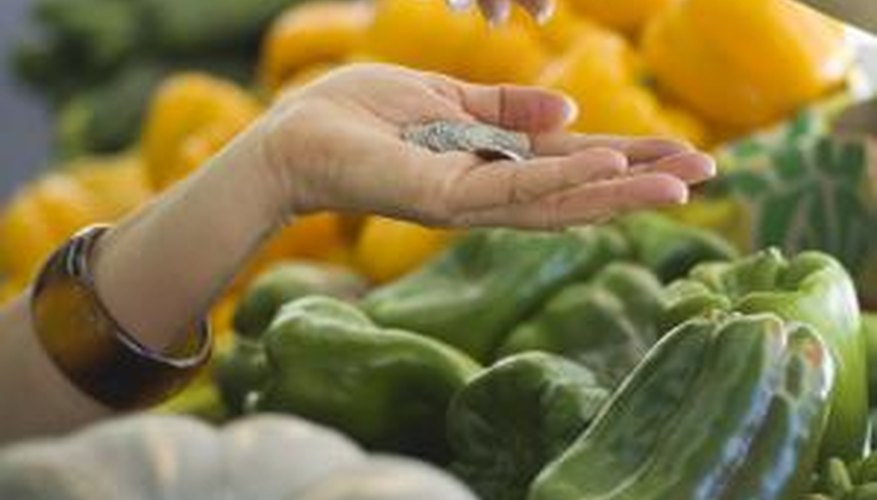A roadside stand provides a glimpse of rural farm life as its operator sells colourful fruits and vegetables to passing motorists. A stand often perches on the edge of a busy road, adjacent to a farm that grows the stand's produce. In other cases, a roadside stand combines the farm's own produce with offerings from other local growers. For example, a roadside stand renowned for its blueberries and orchard-grown fruit may carry other local farmers' fresh vegetables and herbs. Stands that operate every year acquire a loyal customer base through word-of-mouth advertising and newspaper features.
- A roadside stand provides a glimpse of rural farm life as its operator sells colourful fruits and vegetables to passing motorists.
- In other cases, a roadside stand combines the farm's own produce with offerings from other local growers.
Create your roadside stand business organisation. Examples include a sole proprietorship, S corporation, general corporation and limited liability company. Talk to a commercial insurance agent about business and personal liability coverage. Speak to your state department of revenue about whether you need a sales tax license.
Complete the licensing and permit process. Visit your city or county clerk's office to inquire about a roadside stand business license; also ask about locally required permits. Consult your local zoning department to confirm you can operate a roadside stand in that jurisdiction. Call your city's health department to ask about local produce inspection requirements. Contact your state's Department of Agriculture to learn about statewide produce inspection and marketing regulations.
- Complete the licensing and permit process.
- Visit your city or county clerk's office to inquire about a roadside stand business license; also ask about locally required permits.
Find an appropriate roadside stand location. Select a site 10 miles or less from a city or town, as this minimal distance may encourage local residents to make a short trip to your roadside stand. Find a location on a well-traveled road that allows customers to easily see your stand and to visit it without creating a traffic hazard. Look for a spot near a stop sign or traffic light, and ensure that you have adequate customer parking and manoeuvring room.
Build or refurbish a roadside stand. Evaluate your budget and construction talents before you decide on a roadside stand design. If funds are limited, erect a spacious and sturdy tent. Refurbish a structurally sound shed or small outbuilding if appropriate; or build a sturdy structure at a reasonable cost. Ensure interior space is wide enough for customers, including wheelchair users, to navigate without feeling cramped. Apply colourful building paint or create farm-themed wall murals; also consider inflatable fruit or vegetables on the building's roof. Remember you have only a limited time to attract a moving customer's attention.
- Build or refurbish a roadside stand.
- Remember you have only a limited time to attract a moving customer's attention.
Establish your hours, prices and payment methods. Determine your roadside stand's operating hours, and do not deviate from those hours unless an emergency arises. If necessary, hire staff to operate the stand in your absence. Establish your produce prices after examining competitors' prices for similar items. Offer purchase incentives, such as an extra ear of corn and some old-fashioned corn recipes for customers who purchase a dozen ears. Consider other incentives for larger-volume purchases. Select your modes of payment after considering the costs of card processing machines vs. your expected roadside stand income.
- Establish your hours, prices and payment methods.
- Select your modes of payment after considering the costs of card processing machines vs. your expected roadside stand income.
List your roadside stand products. Select your products based on whether you operate the stand on your own property or at another location. A farmer selling produce on his own property likely offers multiple produce varieties during each growing season, as he can easily transport the produce directly from his fields. A seller operating a stand elsewhere often focuses on a few products at one time. Consider produce that has been well-received by area customers. Sweetcorn and tomatoes are excellent examples of colourful produce that draws customers to roadside stands.
- List your roadside stand products.
- Select your products based on whether you operate the stand on your own property or at another location.
Display your colourful produce. Create a colour patchwork by placing differently coloured produce varieties next to each other. For example, zucchini, tomatoes and yellow squash provide striking colour contrasts. Display your produce on tiered shelves if space allows, or feature selected items on small wooden blocks placed on the display counter. Keep all produce out of direct sunlight, and place your most perishable items in the shadiest part of the stand. Add clearly written table signage that identifies each fruit or vegetable. List each item's price, along with a suggested use for that produce. For example, recommend a homemade spaghetti sauce made from your succulent tomatoes; or a corn pudding made from your delicious sweetcorn.
Market to your roadside stand customers. Attract customers with eye-catching sandwich board signage featuring colourful hand-painted fruits and vegetables. Place the signs on your property or obtain written approval to install the signage on other private property. Do not place signage on state or local highway property without written approval. Attract more attention by placing a colourful, easy-to-read sign on the front of your building or shed.
- Market to your roadside stand customers.
- Attract more attention by placing a colourful, easy-to-read sign on the front of your building or shed.
Offer customers fresh fruit samples along with recipes that incorporate that fruit. Offer fresh vegetables with a tasty dip, along with recipes for those types of produce. Ask for customer mailing addresses or e-mail addresses, and use this information to create a customer mailing list. Notify local and regional customers about new fruits and vegetables, along with other locally produced items such as herbs or honey.
